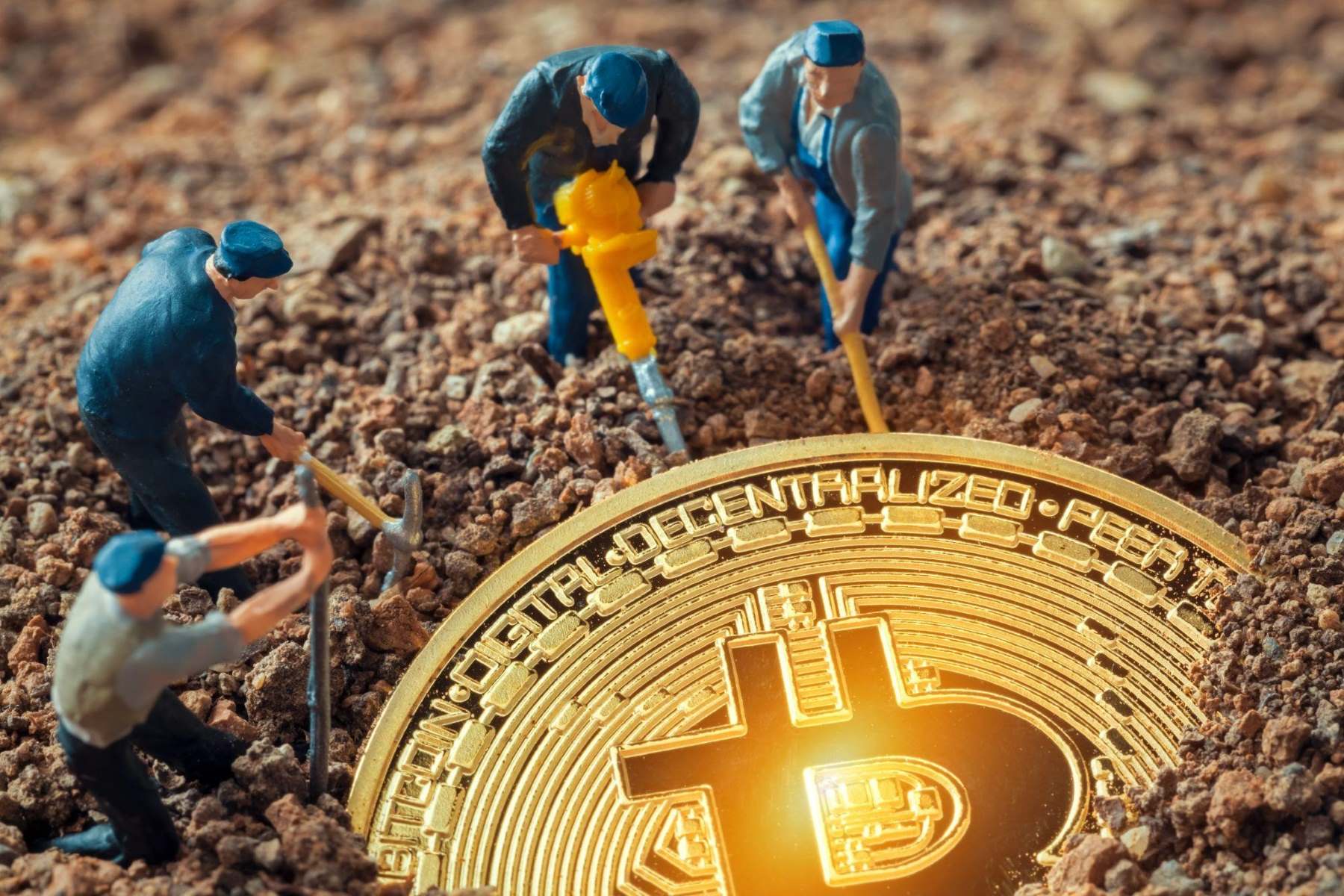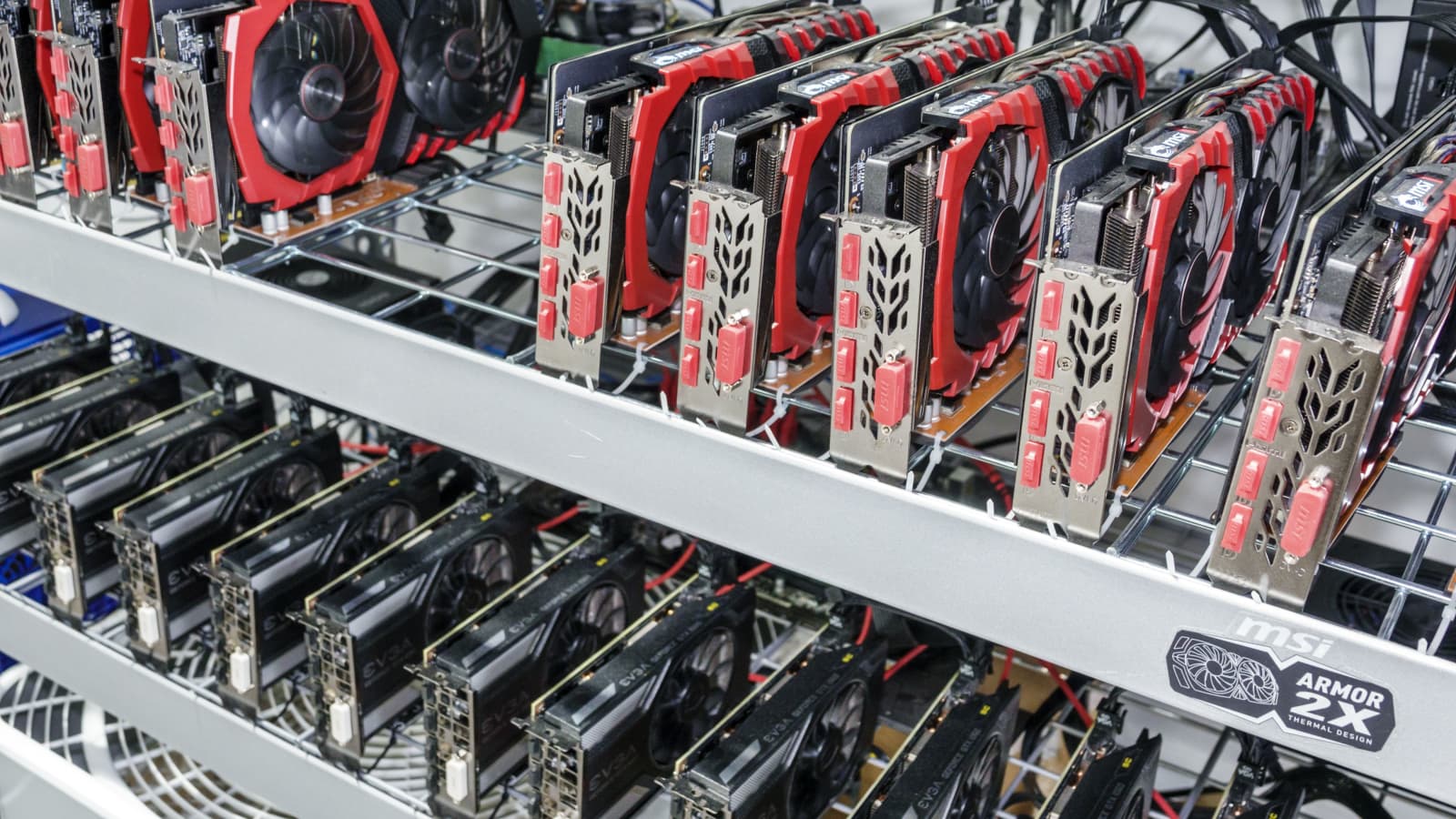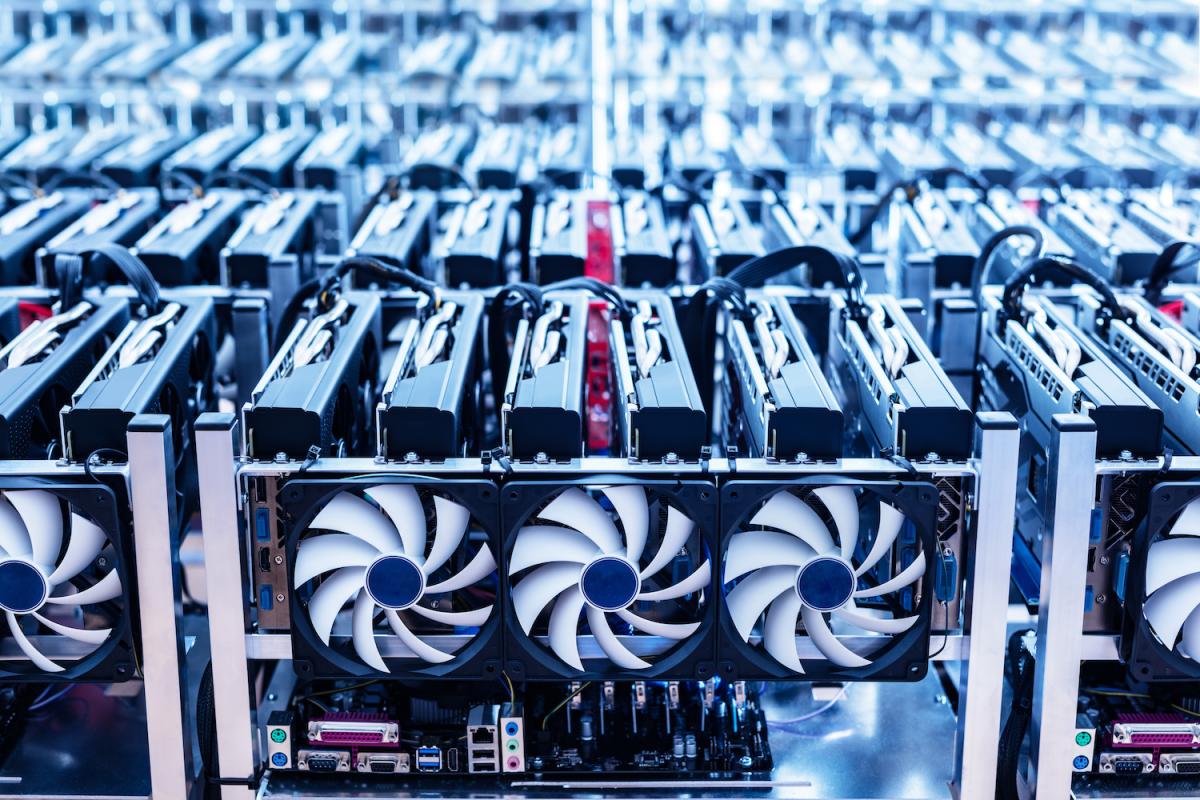Introduction
Welcome to the world of crypto mining, where digital currencies are created through complex algorithms and powerful computing processes. Crypto mining has gained immense popularity in recent years, as it offers an opportunity to generate passive income and participate in the exciting realm of cryptocurrency.
But what exactly is crypto mining? How does it work? And how can you get started on your own mining adventure? In this article, we will delve into the fundamentals of crypto mining, equip you with the necessary knowledge to set up your mining operation, and offer tips to maximize your mining profitability.
Crypto mining is the process of verifying and adding transactions to a blockchain, the digital ledger that records all cryptocurrency transactions. The miners use high-powered computers to solve mathematical puzzles and validate the authenticity of transactions. Once a miner successfully solves a block, they are rewarded with a certain amount of cryptocurrency.
The decentralized nature of cryptocurrencies, like Bitcoin and Ethereum, necessitates the need for mining. Unlike traditional currencies that are issued and regulated by central banks, cryptocurrencies rely on a consensus mechanism known as proof-of-work (PoW). This mechanism requires miners to solve complex mathematical problems to verify transactions and ensure the security and immutability of the blockchain.
Choosing the right cryptocurrency to mine is crucial for your mining success. Factors such as market demand, mining difficulty, and potential profitability should be considered. While Bitcoin remains the most well-known and valuable cryptocurrency, the high mining difficulty and cost-intensive nature of Bitcoin mining may not be feasible for everyone. Fortunately, there are numerous alternative cryptocurrencies, commonly known as altcoins, which offer potential for mining profitability.
Before jumping into the world of crypto mining, you’ll need to consider the hardware requirements. High-performance graphics processing units (GPUs) or specialized mining hardware known as application-specific integrated circuits (ASICs) are essential for efficient mining operations. These devices are designed to perform the complex calculations required for mining, enabling you to maximize your mining potential.
What is Crypto Mining?
Crypto mining, short for cryptocurrency mining, is the process of validating and verifying cryptocurrency transactions by solving complex mathematical problems. It plays a vital role in maintaining the security and integrity of digital currencies, such as Bitcoin, Ethereum, and many others.
At its core, crypto mining involves using a computer’s processing power to solve complex mathematical equations. These equations are used to validate transactions and add them to the blockchain, which is essentially a digital ledger that records all transactions made using a particular cryptocurrency.
The mining process is based on a consensus mechanism called proof-of-work (PoW). Miners compete against each other to solve these mathematical puzzles, and the first miner to find the correct solution is rewarded with a certain amount of cryptocurrency as a reward. This process is often referred to as “mining a block.”
While Bitcoin mining is the most well-known form of crypto mining, other cryptocurrencies also utilize mining to validate transactions and maintain their respective blockchains. However, the specific algorithms and hashing functions used may vary from one cryptocurrency to another.
Mining requires significant computational power, and as cryptocurrencies become more popular and valuable, the difficulty of mining increases. Miners often use specialized hardware, such as high-performance GPUs (graphics processing units) or ASICs (application-specific integrated circuits), to tackle the computational challenges and improve their chances of successfully mining blocks.
It’s important to note that crypto mining is not a risk-free endeavor. The upfront costs for mining hardware, electricity consumption, and ongoing maintenance can be significant. Additionally, as more miners join the network, the mining difficulty increases, which can reduce individual mining profitability.
However, with the right hardware, efficient mining strategies, and carefully chosen cryptocurrencies, it is still possible for individuals to generate income through crypto mining. It requires a combination of technical knowledge, financial awareness, and a willingness to adapt to the ever-changing crypto landscape.
In the next sections, we will explore how crypto mining works in more detail, discuss the hardware and software requirements, and provide tips and strategies to maximize your mining profitability.
How Does Crypto Mining Work?
Crypto mining operates on the principle of a decentralized ledger system known as a blockchain. When a cryptocurrency transaction occurs, it needs to be verified and added to the blockchain to ensure its validity and prevent double-spending. This is where crypto mining comes into play.
Miners use their computational power to solve complex mathematical puzzles, known as hashing functions, that validate transactions. These puzzles require substantial computational resources to solve, making it impractical for any single entity or group to manipulate the blockchain.
When a miner successfully solves a hashing function, they create a new block containing a set of verified transactions. This block is then added to the blockchain, and the miner is rewarded with a certain amount of cryptocurrency for their efforts.
The mining process involves a few key components:
- Hashing: A hashing function takes an input (block of transactions) and produces a fixed-length output. This output, known as a hash, is unique to the input data. Miners must find a hash that meets specific criteria set by the cryptocurrency’s protocol through a trial-and-error process.
- Proof-of-Work: The hashing process requires significant computational power, making it difficult and resource-intensive. This ensures that miners invest real-world resources, such as time and energy, to secure the network.
- Block Reward: Miners are incentivized to participate in the mining process through block rewards. These rewards are predetermined by the cryptocurrency protocol and are usually a combination of newly minted coins and transaction fees.
- Difficulty Adjustment: As more miners join the network, the difficulty of the hashing functions increases. This adjustment maintains a consistent block production rate, ensuring that new blocks are added to the blockchain at a predetermined rate.
It’s important to note that the mining process requires a significant amount of computational power and electricity. Miners often invest in specialized hardware, such as GPUs or ASICs, to increase their mining efficiency and chances of solving the hashing functions. Additionally, the cost of electricity and cooling must be factored in, as mining operations can consume substantial amounts of energy.
While Bitcoin mining is known for its high level of difficulty and resource requirements, there are also alternative cryptocurrencies, called altcoins, that can be mined using less powerful hardware. These altcoins may offer more accessible mining options and potentially higher profitability for individual miners.
In the next sections, we will explore the hardware and software requirements for crypto mining, as well as provide guidance on setting up a mining rig, joining mining pools, and evaluating mining profitability.
Choosing the Right Cryptocurrency to Mine
When it comes to crypto mining, choosing the right cryptocurrency to mine is crucial for maximizing your profitability. While Bitcoin is the most well-known and valuable cryptocurrency, it may not be the most practical option for individual miners due to its high mining difficulty and resource requirements. Fortunately, there are numerous alternative cryptocurrencies, commonly known as altcoins, that offer potential for mining success.
When selecting a cryptocurrency to mine, consider the following factors:
- Market Demand: Choose a cryptocurrency that has a strong and active market. A high demand for the cryptocurrency can lead to increased liquidity and potential profitability.
- Mining Difficulty: Each cryptocurrency has its own mining difficulty, which determines how hard it is to solve the mathematical puzzles and mine new blocks. Lower mining difficulty makes it easier to mine coins and potentially increases profitability.
- Block Rewards: Look for cryptocurrencies that offer attractive block rewards, consisting of newly minted coins and transaction fees. A higher block reward can lead to greater mining profitability.
- Hardware Compatibility: Ensure that the cryptocurrency you choose is compatible with your mining hardware. Some cryptocurrencies require specialized mining hardware, such as ASICs, while others can be mined using GPUs or even CPUs.
- Long-term Viability: Consider the long-term viability and potential of the cryptocurrency. Look at the development team, the technology behind the cryptocurrency, and its community support. A cryptocurrency with a strong foundation and active development can have a brighter future.
Popular altcoins that are often preferred by individual miners include Ethereum, Litecoin, Monero, and Zcash, among others. These cryptocurrencies offer diverse mining opportunities and may have lower barriers to entry compared to Bitcoin.
It’s also worth considering profitability calculators and mining forums to gather insights and information about potential cryptocurrency choices. These resources can help you estimate the profitability of mining specific cryptocurrencies based on factors such as hash rate, electricity cost, and current market conditions.
Remember, mining cryptocurrency is not without risks. Market volatility, changes in mining difficulty, and electricity costs can all impact your profitability. It’s essential to conduct thorough research, stay informed about market trends, and regularly evaluate the profitability of your mining operations.
In the next sections, we will discuss the hardware and software requirements for crypto mining and guide you through the process of setting up a mining rig for your chosen cryptocurrency.
Hardware Requirements for Crypto Mining
To successfully engage in crypto mining, you’ll need to ensure you have the right hardware in place. The hardware requirements for mining will depend on the specific cryptocurrency you choose to mine, as different cryptocurrencies may require different levels of computational power. Here are some key components to consider:
- GPU (Graphics Processing Unit): In many cases, a high-performance GPU is essential for efficient mining. GPUs are specifically designed to handle complex mathematical calculations, making them suitable for mining cryptocurrencies such as Ethereum, Litecoin, and others. It’s crucial to select a GPU that offers a good balance between mining performance, power consumption, and cost.
- CPU (Central Processing Unit): While GPUs are typically the primary driver for mining operations, some cryptocurrencies can still be mined using a CPU. However, CPUs are generally less efficient compared to GPUs when it comes to mining, so their mining capabilities may be limited.
- ASIC (Application-Specific Integrated Circuit): Certain cryptocurrencies, such as Bitcoin, have such high mining difficulty that using specialized hardware, known as ASICs, becomes necessary. ASICs are designed solely for mining cryptocurrencies and offer substantially higher computational power and energy efficiency compared to GPUs or CPUs. However, ASICs are usually expensive and may not be practical for beginners or miners targeting alternative cryptocurrencies.
- Motherboard: A motherboard acts as the backbone of your mining rig and provides connectivity for all the other components. Look for a motherboard that supports multiple GPUs or ASICs and has sufficient PCIe slots to accommodate your hardware requirements.
- Power Supply Unit (PSU): Mining operations consume significant amounts of power, so a reliable and efficient PSU is crucial. Consider the power requirements of your mining hardware and ensure the PSU can handle the load. Additionally, using a power supply with a high efficiency rating can help reduce electricity costs.
- Storage: You’ll need storage to install the operating system and mining software. A solid-state drive (SSD) or a fast hard disk drive (HDD) with sufficient capacity is usually sufficient for this purpose.
- Cooling: Mining operations produce a considerable amount of heat, so proper cooling is essential to prevent hardware damage and ensure optimal performance. Consider investing in quality cooling solutions, such as fans or liquid cooling systems, to keep your mining rig at an optimal temperature.
When it comes to crypto mining hardware, it’s important to strike a balance between mining performance, power consumption, and cost. Researching and comparing different hardware options, reading user reviews and mining forums, and staying up-to-date with the latest developments in mining hardware can help you make informed decisions.
Keep in mind that hardware requirements may evolve as cryptocurrency technology advances or as new mining algorithms are implemented. Therefore, it’s essential to stay informed and regularly reassess your hardware needs to adapt to the changing mining landscape.
In the next section, we will explore the software requirements for crypto mining and guide you through the process of setting up the necessary software components for your mining operations.
Software Requirements for Crypto Mining
Alongside the necessary hardware, crypto mining also requires specific software components to facilitate the mining process and connect you to the cryptocurrency network. Here are the essential software requirements for crypto mining:
- Mining Software: The primary software you’ll need is mining software, which allows your hardware to communicate with the cryptocurrency network and perform the mining calculations. There are various mining software options available, depending on the cryptocurrency you’re mining and the hardware you’re using. Examples include CGMiner, BFGMiner, and Claymore’s Miner, among others.
- Operating System: You’ll need a reliable operating system to run your mining software and manage your mining rig. Popular choices for mining include Linux-based distributions like Ubuntu or specialized mining operating systems like SimpleMining OS or EthOS. Windows can also be used, but it may require additional configuration and optimization.
- Wallet Software: A cryptocurrency wallet is essential for securely storing your mined coins. Mining software can often be configured to send the rewards directly to your wallet. Each cryptocurrency typically has its own wallet software, which can be obtained from the official project website. It’s crucial to choose a wallet that supports the specific cryptocurrency you’re mining.
- Monitoring and Management Tools: To keep track of your mining performance and maintain your mining operations, it’s beneficial to use monitoring and management tools. These tools provide insights into your mining hardware’s temperature, power consumption, hash rate, and potential issues. Popular options include MSI Afterburner, GPU-Z, and Awesome Miner.
- Security and Antivirus Software: Mining software and related tools can sometimes be targeted by malicious actors. To protect your mining rig and data, it’s essential to have security measures in place. Install reputable antivirus software to detect and prevent any potential threats.
When setting up your software components, ensure that you have the latest versions and follow the installation instructions provided by the respective software developers. Additionally, frequent backups of your wallet and important data are crucial to protect against data loss or hardware failures.
It’s worth noting that some cryptocurrencies may have specific requirements or software peculiarities that you need to be aware of. Stay updated with the news and developments within the crypto community to ensure you’re using the appropriate software configurations and updates.
Setting up and fine-tuning your software components can be a process of trial and error. Be prepared to spend time experimenting with different settings and optimizations to maximize your mining efficiency and profitability.
In the next section, we will guide you through the process of setting up a crypto mining rig, including the hardware and software integration required for successful mining operations.
Setting Up a Crypto Mining Rig
Setting up a crypto mining rig involves integrating the necessary hardware components and configuring the software components to initiate your mining operations. Here are the essential steps to guide you through the process:
- Choose the Mining Hardware: Select the appropriate hardware based on the cryptocurrency you’re mining. Consider factors such as mining performance, power consumption, and budget. Ensure compatibility between the hardware components, such as the GPU, motherboard, and power supply.
- Assemble the Hardware: Carefully connect all hardware components, including the GPU(s), CPU, RAM, motherboard, storage devices, and power supply unit (PSU). Ensure the connections are secure and all components are properly seated in their respective slots.
- Install the Operating System: Install the preferred operating system for your mining rig, whether it’s a Linux-based distribution, a specialized mining operating system, or Windows. Follow the installation instructions provided by the operating system’s developer.
- Configure the BIOS/UEFI Settings: Access the BIOS/UEFI settings of your mining rig’s motherboard and configure it to optimize your mining operations. Set the boot order, enable any necessary additional settings, and ensure that the hardware is recognized properly.
- Install and Configure the Mining Software: Download and install the mining software that is compatible with your chosen cryptocurrency and hardware. Configure the software with the appropriate mining pool and wallet information. Adjust any settings specific to your mining rig, such as fan speeds or GPU overclocking, to achieve optimal performance.
- Test and Monitor Your Mining Rig: Before starting the full mining process, run some test mining operations to ensure everything is functioning correctly. Monitor the temperature, fan speeds, and hash rate of your mining rig using monitoring tools. Make any necessary adjustments to improve stability and performance.
- Connect to a Mining Pool: To increase your chances of earning consistent mining rewards, consider joining a mining pool. A mining pool combines the collective computing power of multiple miners to mine blocks more efficiently and distribute rewards proportionally. Follow the instructions provided by the mining pool to connect your mining rig to their network.
Throughout the setup process, keep in mind that each cryptocurrency may have specific software configurations and optimizations that you may need to research and experiment with. Stay up-to-date with the latest developments in the mining community, read forums, and consult mining guides to optimize your mining rig’s performance.
It’s crucial to regularly monitor and maintain your mining rig’s hardware and software components. Keep an eye on temperature levels, power consumption, and the overall stability of the system. Regularly update your software, including the mining software and operating system, to ensure you have the latest features and security enhancements.
In the next section, we will explore the benefits of joining a mining pool and provide insights into mining strategies and tips to help you maximize your mining profitability.
Joining a Mining Pool
Joining a mining pool is a popular choice for crypto miners who want to increase their chances of earning consistent mining rewards. The process of mining on your own can be challenging, especially for individual miners with limited computational power. By joining a mining pool, you can combine your resources with other miners to collectively mine blocks and share in the rewards.
Here are the key benefits of joining a mining pool:
- Increased Mining Efficiency: Mining pools allow miners to collectively contribute their computational power, increasing the chances of solving blocks and earning rewards more frequently. This effectively boosts the efficiency of mining operations, particularly for miners with limited resources.
- Steady and Regular Payouts: Mining pools distribute mining rewards among their participants based on their contributed computational power. Instead of receiving sporadic rewards when mining solo, joining a pool provides a more consistent and predictable income stream.
- Reduced Variability of Mining Returns: Cryptocurrency mining can be subject to significant variability due to fluctuations in mining difficulty and block rewards. By mining through a pool, the variability of your individual mining returns is mitigated, creating a more stable income stream.
- Elimination of High Mining Difficulty: Some cryptocurrencies have high mining difficulty levels, making it challenging for individual miners to compete. Mining pools allocate the computational power of their participants, enabling them to collectively tackle difficult hashing functions and mine blocks more efficiently.
- Access to Support and Resources: Mining pools often provide technical support, forums, and resources to help miners optimize their mining operations. This can be invaluable, especially for beginners who may need assistance with software configuration, hardware optimization, or troubleshooting.
To join a mining pool, follow these general steps:
- Select a Mining Pool: Research and choose a mining pool that supports the cryptocurrency you’re mining. Consider factors such as the pool’s reputation, fees, minimum payout thresholds, and the distribution method of mining rewards.
- Create an Account: Visit the pool’s website and sign up for an account. Provide the necessary information and create a wallet address if required.
- Configure Your Mining Software: Set up your mining software to connect to the mining pool. This typically involves providing the pool’s server address, port number, and your account details. The specific configuration instructions will vary depending on the mining software you’re using.
- Join the Pool: After configuring your mining software, start it up and connect to the mining pool. Monitor the mining process through the mining pool’s website or monitoring tools to ensure your mining rig is properly connected and contributing to the pool’s collective mining efforts.
- Monitor and Optimize: Regularly monitor your mining pool’s statistics, such as your hashrate and earnings. Fine-tune your mining rig’s settings and consider optimizing your hardware or software configurations to maximize your mining efficiency within the pool.
- Set Up Payouts: Determine the payout method provided by the mining pool, whether it’s automatic, manual, or based on a certain balance threshold. Configure your payout settings within the mining pool’s platform to ensure you receive your earned rewards.
Joining a mining pool allows you to participate in the mining ecosystem without the need for extensive resources or technical expertise. It can be a rewarding and more accessible way to engage in crypto mining while enjoying the benefits of collective mining efforts.
In the next section, we will explore different mining strategies and provide tips to help you maximize your mining profitability.
Mining Strategies and Tips
When it comes to crypto mining, implementing effective strategies and tips can significantly enhance your mining profitability. Here are some valuable strategies and tips to consider:
- Choose the Right Mining Pool: Do thorough research and select a reputable mining pool that aligns with your mining goals. Consider factors such as pool fees, payout methods, and pool size. Joining a larger and more established pool can provide a more consistent mining experience.
- Balance Mining Profitability and Network Health: Take into account the profitability of mining a specific cryptocurrency as well as the health and stability of its network. Mining a highly profitable but unstable cryptocurrency may come with increased risks, so consider striking a balance between potential profits and network reliability.
- Monitor Mining Difficulty and Market Trends: Keep a close eye on the mining difficulty of your chosen cryptocurrency. As more miners join the network, mining difficulty increases, potentially impacting your profitability. Stay updated with market trends and adjust your mining strategy accordingly.
- Optimize Power Consumption: Electricity costs can significantly impact your mining profitability. Optimize your mining rig’s power consumption by adjusting settings such as GPU power limits, undervolting, and fan speeds. Also, consider mining during off-peak hours when electricity rates may be lower.
- Diversify Your Mining Portfolio: Instead of solely focusing on a single cryptocurrency, consider diversifying your mining portfolio by mining multiple cryptocurrencies. This approach allows you to take advantage of various market conditions and potentially increase your overall mining profitability.
- Stay Updated with Technology Advancements: The world of cryptocurrency mining is constantly evolving, with new technologies and algorithms emerging. Stay informed about the latest advancements in mining hardware, software, and mining algorithms to ensure you’re leveraging the best tools and techniques available.
- Regularly Evaluate and Adjust: Regularly assess and evaluate the performance of your mining operations. Monitor your mining rig’s statistics, such as hashrate, power consumption, and profitability, and make necessary adjustments to optimize your mining strategy. This may include upgrading hardware, adjusting software settings, or changing the cryptocurrencies you mine.
- Implement Proper Risk Management: Crypto mining carries certain risks, including market volatility and hardware failures. Set realistic expectations and allocate resources wisely. Consider factors such as the cost of hardware, electricity expenses, and potential returns. It’s important to have a well-thought-out risk management strategy in place.
Keep in mind that mining profitability can vary based on market conditions, mining difficulty, and the specific hardware and software you’re using. It’s crucial to stay informed, adapt to changing circumstances, and continuously optimize your mining strategy to maximize your profitability and long-term success as a crypto miner.
Remember, mining is a resource-intensive activity that requires careful planning, technical knowledge, and ongoing maintenance. By implementing effective mining strategies and following these tips, you can improve your chances of success in the dynamic world of crypto mining.
In the final section, we will explore how to evaluate the profitability of your mining operations and provide insights on managing and securing your crypto mining activities.
Evaluating Mining Profitability
Evaluating the profitability of your mining operations is crucial to ensure that your efforts yield the desired financial returns. Here are some important factors to consider when assessing the profitability of your mining endeavors:
- Electricity Costs: The cost of electricity is a significant factor in mining profitability. Calculate the electricity consumption of your mining rig and determine the associated expenses. Consider your electricity rate and look for ways to optimize power consumption to reduce costs.
- Mining Difficulty: Mining difficulty is a measure of how hard it is to solve the mathematical puzzles required to mine blocks. As mining difficulty increases, it can impact your mining profitability. Monitor the mining difficulty of your chosen cryptocurrency and adjust your strategy accordingly.
- Mining Rewards: Understand the block rewards and transaction fees associated with the cryptocurrency you are mining. Keep track of any changes in the reward structure or halving events, as they can impact your earnings. Consider the potential returns based on the current market conditions.
- Mining Hardware Efficiency: The efficiency and performance of your mining hardware impact your mining profitability. Ensure that your hardware is optimized for the specific cryptocurrency you are mining. Regularly monitor hardware statistics, such as hashrate and power consumption, to identify opportunities for improvement.
- Market Conditions: Cryptocurrency prices are subject to market volatility. Stay informed about market trends and assess how fluctuations in prices can impact your mining profitability. Consider factors such as demand, trading volume, and overall market sentiment.
- Mining Pool Fees: If you are part of a mining pool, take note of any fees associated with participation. Some mining pools deduct a percentage of mining rewards as fees. Evaluate the impact of these fees on your overall profitability and consider switching pools if necessary.
- Operational Expenses: In addition to electricity costs, consider other operational expenses such as mining software fees, hardware maintenance, cooling, and general maintenance. Account for these expenses in your overall profitability calculations.
To evaluate the profitability of your mining operations, it’s crucial to track and analyze relevant data, such as daily or monthly earnings, electricity costs, and overall expenses. Consider using online mining calculators that take into account various factors and provide estimated profitability based on the inputs provided.
Regularly reassess your mining strategy and adjust as needed. Monitor the performance of your mining rig, the fluctuations in mining difficulty, and changes in the cryptocurrency market. Stay informed about new mining opportunities and consider diversifying your mining portfolio to spread the risks and maximize your potential earnings.
Remember that profitability can vary over time due to changing market conditions and mining dynamics. It’s essential to set realistic expectations, conduct thorough research, and adapt your mining strategy to optimize your long-term profitability as a crypto miner.
In the final section, we will explore how to effectively manage and secure your crypto mining operations to ensure a smooth and successful mining experience.
Managing and Securing Your Crypto Mining Operations
Managing and securing your crypto mining operations is vital to ensure the smooth and secure functioning of your mining rig, as well as the protection of your mined coins. Here are some essential practices to consider:
- Security Measures: Implement robust security measures to safeguard your mining rig and digital assets. Use strong and unique passwords for your mining software, wallets, and online accounts. Enable two-factor authentication (2FA) wherever possible, and keep your operating system and software up to date with the latest security patches.
- Regular Backups: Regularly back up your wallet files and important mining-related data to external storage devices or cloud-based services. In the event of hardware failure or other unforeseen circumstances, having backups ensures you can recover your data and access your mined coins.
- Network Security: Protect your mining rig from unauthorized access by ensuring your local network is secure. Use a strong password for your router and enable encryption (e.g., WPA2) for your Wi-Fi network. Disable remote management features on your mining hardware to minimize potential vulnerabilities.
- Mining Software Updates: Stay up to date with the latest versions of mining software. Software updates often include bug fixes, performance improvements, and security patches. Regularly check for updates and install them to benefit from the latest features and protect against potential vulnerabilities.
- Monitor Hardware Health: Regularly monitor the health of your mining rig’s hardware. Check temperature levels, fan speeds, and other vital statistics to ensure optimal performance. Dust and clean your mining rig periodically to prevent overheating and hardware malfunctions.
- Stay Informed: Stay up to date with the latest news and developments in the crypto mining community. Follow reliable mining resources, forums, and social media channels to stay informed about potential changes to mining algorithms, new coins, or security threats.
- Minimize Downtime: Minimize the downtime of your mining rig to maximize your mining profitability. Set up remote access to your mining rig so you can troubleshoot and address issues promptly. Implement backup hardware components to minimize interruptions in case of hardware failures.
- Maintain Records and Financial Tracking: Keep detailed records of your mining operations, including earnings, expenses, and tax-related information. This will help you accurately assess your profitability, track the performance of your mining rig, and ensure compliance with taxation regulations.
Additionally, consider joining mining communities and online forums to connect with other miners, exchange knowledge, and stay updated with mining best practices. Sharing experiences and learning from others can help you refine your mining strategies and overcome challenges.
Remember that crypto mining involves financial risk, technical challenges, and changing market dynamics. Regularly evaluate your mining profitability, adapt to market conditions, and be prepared to adjust your strategy when necessary to ensure continued success.
By implementing effective management and security practices, you can enhance the overall reliability, security, and profitability of your crypto mining operations.
Now that you are equipped with the knowledge necessary to manage your mining operations effectively, you are ready to embark on your crypto mining journey. Best of luck!
Conclusion
Crypto mining presents an exciting opportunity to participate in the world of cryptocurrencies and potentially generate passive income. By understanding the fundamentals of crypto mining, choosing the right cryptocurrency to mine, setting up the appropriate hardware and software components, and implementing effective strategies, you can optimize your mining profitability. However, it is essential to remember that mining involves risks and challenges that need to be managed.
Throughout this article, we have explored the key aspects of crypto mining, including what it is, how it works, hardware requirements, software requirements, setting up a mining rig, joining mining pools, mining strategies, evaluating profitability, and managing and securing your mining operations.
Crypto mining requires dedication, technical knowledge, and ongoing effort to stay up to date with industry developments. It’s important to regularly assess and adapt your mining strategy based on market conditions, mining difficulty, and profitability calculations. Continuously monitor your mining rig’s performance, implement security measures, and stay informed about advancements in mining technology.
Remember, success in crypto mining depends on various factors, including the choice of cryptocurrency, mining hardware, software configurations, and market conditions. There will be challenges along the way, but with proper research, planning, and perseverance, you can navigate the dynamic world of crypto mining and maximize your potential for success.
As you embark on your crypto mining journey, stay informed, adapt to changing circumstances, and continuously refine your strategy. Best of luck in your mining endeavors!

























